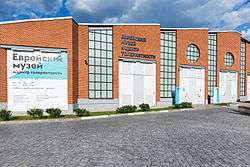Jewish Museum and Tolerance Center
The Jewish Museum and Tolerance Center opened in Moscow in November 2012. Construction of the museum is estimated to have cost $50 million. Vladimir Putin personally donated one month of his salary towards the construction of the museum.[1][2]
 | |
| Established | 2012 |
|---|---|
| Location | Obraztsova st., 11 Moscow, Russia |
| Website | www |
Features
This large and engaging museum dedicated to the complex history of Russian Jewry, is thoroughly modern in approach, favouring personal testimony, archival video footage and interactive displays—all translated into Russian and English. The exhibitions are divided chronologically, helping visitors to understand the life of Jewish communities as they travelled across medieval Europe, settling in shtetls before moving to the cities. The role of Russian Jewry in public life in the late 19th and early 20th centuries is particularly well presented as is the fate of Soviet Jews and the role of Jewish soldiers during World War II. Visitors of Russian-Jewish origins will no doubt be particularly interested in hearing about what it meant to be a "Soviet Jew" and finding out how and why so many left the USSR. Those expecting to find just a stark representation of pogroms, Holocaust, hardships and suffering will be pleasantly surprised to find Russian Jewish history presented as something much more complex, filled with both struggles and achievements. The museum is located in the northwestern Moscow neighborhood of Marina Roscha and can also be reached by taking tram no.19 from metro Novoslobodskaya.
History
_01.jpg)
According to a May 2014 article by Alexis Zimberg in the Calvert Journal, the new Jewish Museum occupies the restored Bakhmetevsky Bus Garage. The 8,500-square-metre space is a landmark of the avant-garde 1920s. Designed by architect Konstantin Melnikov and structural engineer Vladimir Shukhov in 1926, the angled parallelogram building went from blueprint to structure in just one year. Vaulted ceilings and clean architectural angles echo an early Soviet mantra: ever higher, comrades, toward the radiant future. Melnikov and Shukhov even designed the interior lighting to resemble slanted rays of sunshine. In the 1990s, a fire left the garage decrepit and dysfunctional. Following mass restoration efforts it re-opened in 2008, initially to house the Garage Centre for Contemporary Culture. And then in 2012, thanks to generous funding from oligarchs like Roman Abramovich and Viktor Vekselberg, from Jewish organisations like FEOR and Chabad Lubavitch—even with the support of President Vladimir Putin himself—a site that had once represented another aspect of Soviet state control became home to the world's largest Jewish museum.[3]
Trustees
The board of trustees of the museum are various billionaire oligarchs who benefited from the privatization in Russia during the 1990s; Viktor Vekselberg, Gennady Timchenko, Len Blavatnik, Roman Abramovich, Vadim Moshkovich, Alex Lichtenfeld, Alexander Klyachin, Mikhail Gutseriev.[4]
References
- Peres Inaugurates Jewish Museum Funded by Putin, Vekselberg Bloomberg News, By Ilya Arkhipov and Henry Meyer Nov 8, 2012
- Barry, Ellen (2012-11-09). "In Big New Museum, Russia Has a Message for Jews: We Like You". New York Times. Retrieved 2013-01-29.
- Zimberg, Alexis. Free state: Moscow’s Jewish Museum and its quest for an open society. Archived 2014-06-05 at the Wayback Machine The Calvert Journal. London, England. 13 May 2014.
- Еврейский музей и центр толерантности объявил о создании эндаумент-фонда Музея Archived 2014-03-10 at the Wayback Machine http://www.jewish-museum.ru